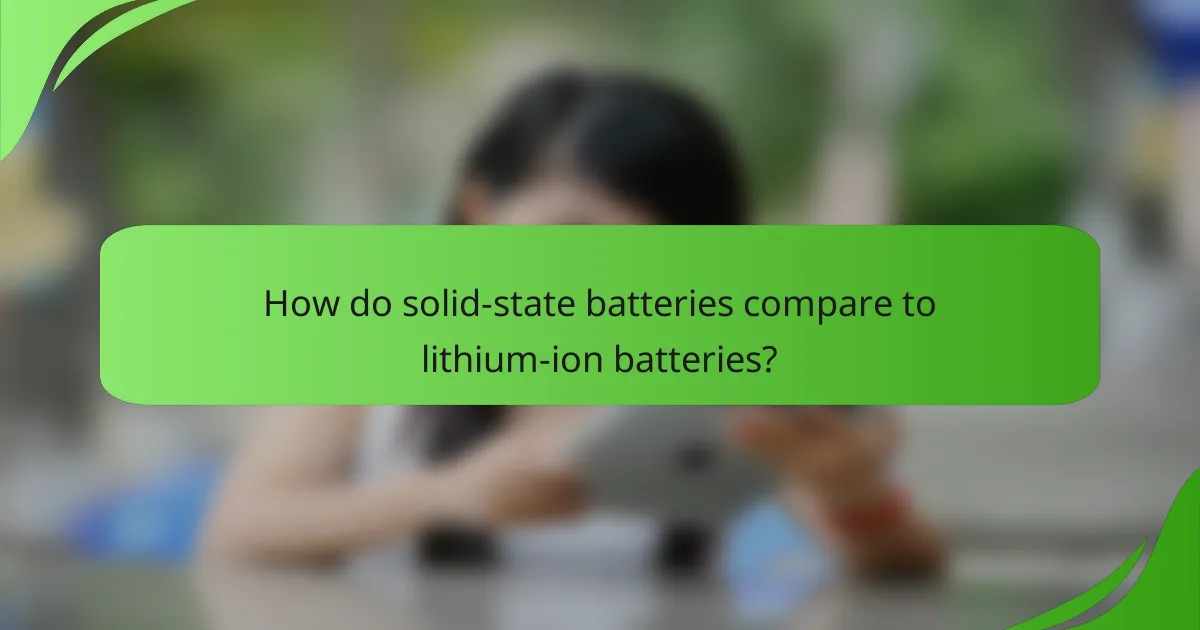Solid-state batteries represent a significant advancement in energy storage technology, boasting advantages such as higher energy density, enhanced safety, and longer lifespans compared to conventional lithium-ion batteries. Despite their potential, challenges like manufacturing complexities and high production costs currently impede their widespread adoption. As research continues, solid-state batteries may play a crucial role in the future of electric vehicles and portable electronics.

What are the advantages of solid-state batteries?
Solid-state batteries offer several advantages over traditional lithium-ion batteries, including higher energy density, improved safety, longer lifespan, faster charging times, and environmental benefits. These features make them a promising option for various applications, particularly in electric vehicles and portable electronics.
Higher energy density
Solid-state batteries can achieve significantly higher energy densities compared to conventional batteries. This means they can store more energy in the same amount of space, which is crucial for applications like electric vehicles where weight and volume are critical factors. Energy densities can reach levels above 300 Wh/kg, allowing for longer ranges on a single charge.
Higher energy density also translates to lighter battery packs, which can improve overall vehicle efficiency and performance. This advantage is essential as manufacturers aim to create lighter and more efficient electric vehicles to compete with traditional combustion engines.
Improved safety features
Safety is a major concern with lithium-ion batteries, particularly due to risks of fire and explosion. Solid-state batteries use solid electrolytes instead of flammable liquid ones, significantly reducing these risks. The solid materials are less likely to leak or catch fire, making them a safer alternative.
Moreover, solid-state batteries are more resistant to thermal runaway, a condition that can lead to catastrophic failure in traditional batteries. This enhanced safety profile is particularly appealing for consumer electronics and electric vehicles, where safety is paramount.
Longer lifespan
Solid-state batteries typically have a longer lifespan than their liquid counterparts, often lasting several thousand charge cycles. This longevity is due to reduced degradation of materials over time, which means users can expect a longer usable life from their devices or vehicles.
A longer lifespan not only reduces the frequency of battery replacements but also lowers the overall cost of ownership. For electric vehicle owners, this can translate to significant savings over the vehicle’s lifetime.
Faster charging times
Solid-state batteries can support faster charging times, often allowing for full charges in under an hour. This rapid charging capability is a significant advantage for electric vehicle users who require quick turnaround times during long trips.
Faster charging is facilitated by the solid electrolyte, which can handle higher currents without the same risks of overheating that liquid electrolytes face. This feature enhances the convenience of using electric vehicles and portable devices.
Environmental benefits
Solid-state batteries offer several environmental advantages, including the potential for reduced reliance on harmful materials. Many solid-state designs can eliminate the need for cobalt, a mineral often associated with unethical mining practices.
Additionally, the longer lifespan of solid-state batteries means fewer batteries end up in landfills, contributing to a lower environmental impact. As the industry moves towards more sustainable practices, solid-state technology is positioned as a greener alternative in the battery market.

What challenges do solid-state batteries face?
Solid-state batteries encounter several significant challenges that hinder their widespread adoption. Key issues include manufacturing complexities, high production costs, material limitations, and scalability concerns.
Manufacturing complexities
The production of solid-state batteries involves intricate processes that require precise control over materials and conditions. Unlike traditional lithium-ion batteries, solid-state designs often necessitate advanced techniques such as vacuum deposition or high-temperature sintering, which can complicate manufacturing lines.
These complexities can lead to increased production times and the need for specialized equipment, making it difficult for manufacturers to scale operations efficiently. As a result, achieving consistent quality across large batches remains a significant hurdle.
High production costs
High production costs are a major barrier to the commercialization of solid-state batteries. The materials used, such as solid electrolytes, can be expensive, and the specialized manufacturing processes further inflate costs. Estimates suggest that production costs could be several times higher than those of conventional lithium-ion batteries.
To make solid-state batteries competitive, manufacturers will need to find ways to reduce these costs, possibly through economies of scale or advancements in material science that lower the price of key components.
Material limitations
Solid-state batteries rely on specific materials that can limit their performance and applicability. For instance, solid electrolytes must exhibit high ionic conductivity while remaining stable under various conditions. Currently, few materials meet these criteria effectively, which can restrict the development of high-performance batteries.
Moreover, the compatibility of these materials with existing battery components is crucial. Incompatibilities can lead to issues such as dendrite formation, which can compromise battery safety and longevity.
Scalability issues
Scalability is a critical challenge for solid-state battery technology. While prototypes may perform well in laboratory settings, transitioning to mass production often reveals unforeseen obstacles. The need for uniformity in material properties and performance across large volumes complicates scaling efforts.
Additionally, the current infrastructure for battery production is largely optimized for traditional lithium-ion technologies. Adapting existing facilities or building new ones to accommodate solid-state battery production can be a costly and time-consuming process.

How do solid-state batteries compare to lithium-ion batteries?
Solid-state batteries offer several advantages over traditional lithium-ion batteries, including higher energy density and improved safety. However, they also face challenges such as higher production costs and slower market adoption.
Performance differences
Solid-state batteries typically provide greater energy density, which means they can store more energy in a smaller volume compared to lithium-ion batteries. This results in longer-lasting power for devices and electric vehicles.
Additionally, solid-state batteries have a lower risk of overheating and are less prone to catching fire, making them a safer option. However, they may currently have slower charging times and limited cycle life compared to some advanced lithium-ion technologies.
Cost comparison
The production costs of solid-state batteries are generally higher than those of lithium-ion batteries due to the complexity of materials and manufacturing processes. Estimates suggest that solid-state batteries can cost up to two to three times more than lithium-ion batteries.
As production techniques improve and economies of scale are achieved, the cost gap may narrow. However, for now, the higher initial investment remains a significant barrier to widespread adoption.
Market adoption rates
Solid-state batteries are still in the early stages of market adoption, primarily used in niche applications such as high-end electronics and some experimental electric vehicles. In contrast, lithium-ion batteries dominate the market due to their established production and supply chains.
Industry experts predict that solid-state batteries could become more mainstream within the next decade as advancements in technology and manufacturing reduce costs and improve performance. However, widespread adoption will depend on overcoming current technical challenges and scaling production effectively.

What is the current state of solid-state battery technology?
Solid-state battery technology is advancing rapidly, characterized by the use of solid electrolytes instead of liquid ones. This shift promises higher energy densities, improved safety, and longer lifespans compared to traditional lithium-ion batteries.
Leading companies in development
Several major companies are at the forefront of solid-state battery development. Notable players include Toyota, which aims to commercialize solid-state batteries for electric vehicles, and QuantumScape, focusing on automotive applications with significant backing from investors like Volkswagen.
Other companies such as Samsung and Panasonic are also investing heavily in research and development, aiming to enhance battery performance and scalability. Startups like Solid Power and Ionic Materials are contributing innovative solutions to overcome existing technical challenges.
Recent breakthroughs
Recent breakthroughs in solid-state battery technology include advancements in solid electrolyte materials that enhance ionic conductivity and stability. For instance, researchers have developed sulfide-based electrolytes that can operate at room temperature, making them more practical for consumer applications.
Additionally, improvements in manufacturing processes are reducing costs and increasing production efficiency. These innovations are paving the way for faster commercialization and wider adoption in various sectors.
Current applications
Currently, solid-state batteries are being explored for use in electric vehicles, consumer electronics, and renewable energy storage. Their higher energy density makes them particularly attractive for electric vehicles, where weight and space are critical factors.
In consumer electronics, companies are testing solid-state batteries for smartphones and laptops, aiming to provide longer battery life and enhanced safety. While widespread adoption is still in progress, pilot projects and prototypes are demonstrating the potential of solid-state technology across these applications.

What is the future potential of solid-state batteries?
The future potential of solid-state batteries lies in their ability to offer higher energy density, improved safety, and faster charging times compared to traditional lithium-ion batteries. As research and development continue, these batteries are expected to play a significant role in various industries, particularly in electric vehicles and portable electronics.
Predicted market growth
The solid-state battery market is anticipated to grow substantially over the next decade, driven by increasing demand for energy-efficient and safe battery solutions. Analysts project a compound annual growth rate (CAGR) ranging from 20% to 30% as manufacturers scale production and technology matures.
Major companies and startups are investing heavily in solid-state technology, indicating strong confidence in its commercial viability. This trend suggests that by the early 2030s, solid-state batteries could capture a significant share of the overall battery market.
Innovations on the horizon
Innovations in solid-state batteries are focused on enhancing performance and reducing production costs. Researchers are exploring new materials, such as lithium sulfide and solid electrolytes, which could lead to batteries with greater energy density and longevity.
Additionally, advancements in manufacturing techniques, like roll-to-roll processing, aim to streamline production and make solid-state batteries more accessible. These innovations could pave the way for widespread adoption across various applications, from consumer electronics to grid storage.
Impact on electric vehicles
Solid-state batteries are poised to revolutionize the electric vehicle (EV) market by providing longer ranges and shorter charging times. With energy densities potentially exceeding 300 Wh/kg, EVs could travel significantly farther on a single charge, addressing one of the main consumer concerns about electric mobility.
Moreover, the enhanced safety profile of solid-state batteries reduces the risk of fires and thermal runaway, making EVs safer for consumers. As automakers integrate this technology, we can expect a shift towards more sustainable and efficient electric transportation solutions.
